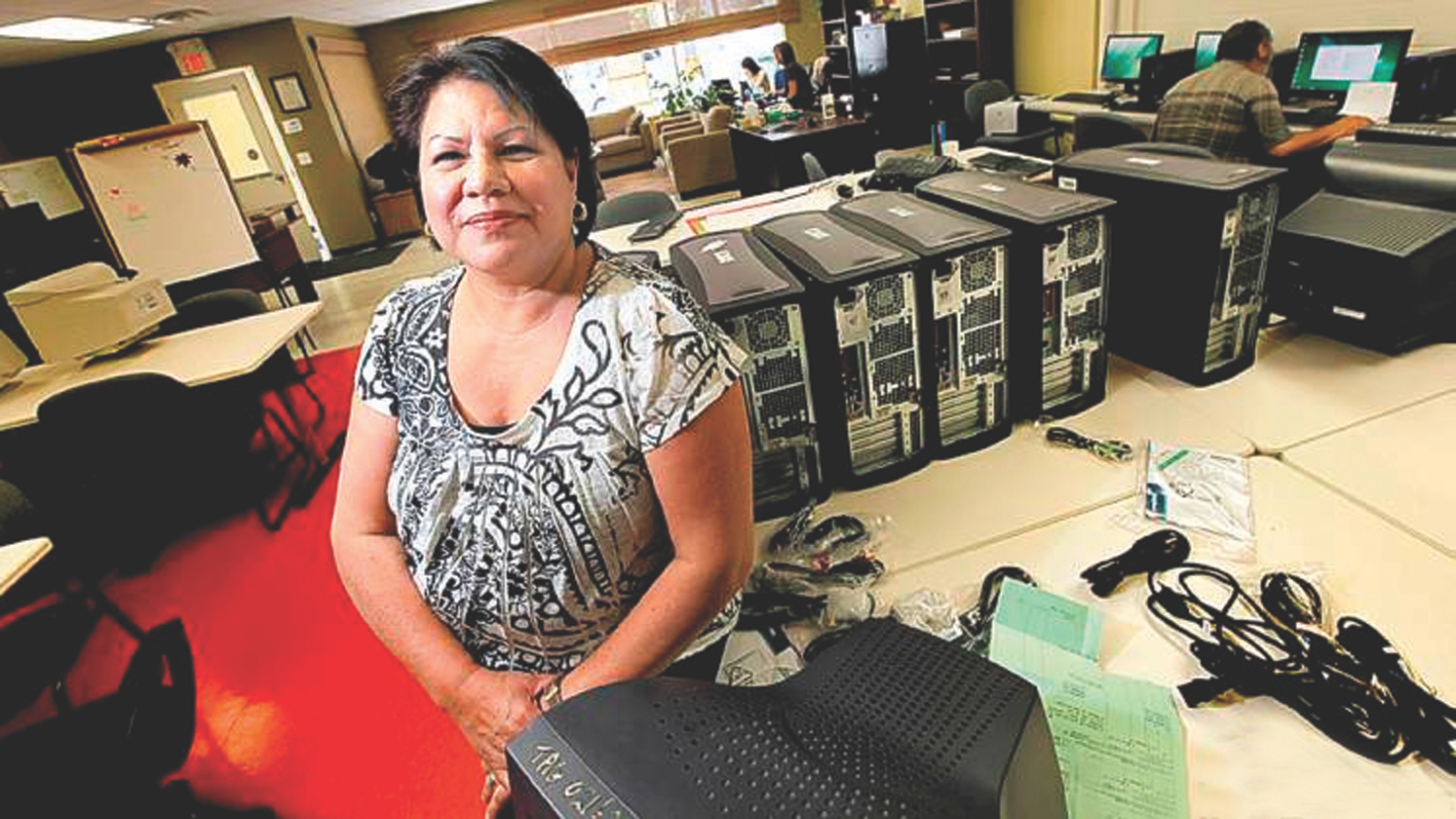Sixteen-year-old Melvin Licona had “a very bad year in 2010,” he says. “The worst. I got in with a bad crowd and did some stuff I shouldn’t have done.”
As a consequence, he lost a year at school and had to repeat Grade 9. It was a different story in 2011, though, the earnest Aboriginal youth says. “This year was pretty good.”
You may unsubscribe from any of our newsletters at any time.
The difference for Licona, and for nearly 90 other high-school-aged kids in the largely Aboriginal neighbourhood of Winnipeg’s North End, is a program called Pathways to Education. Housed in the United Church-owned Stella Community Mission, it will celebrate its second anniversary in the city this spring.
The Winnipeg program is the latest of a growing national network of Pathways programs that are garnering headlines for their remarkable success at helping kids in hard-luck neighbourhoods progress in school. Pathways, a charitable organization based in Toronto, is dedicated to making Canada a “graduation nation,” according to its slogan.
“Our goal is to help youth in low-income communities graduate from high school and make the transition into college or university,” says David Hughes, the president and CEO of Pathways to Education Canada. “We do that by targeting low-income communities where there’s a very high dropout rate. All the kids in the area are eligible to participate when they enter Grade 9. We provide them with the same supports most middle- and upper-class kids take for granted but which are often not available in low-income families.”
Winnipeg is Pathways’ first, and so far only, attempt to address the needs of a largely First Nations student population. Presented with a request from the community to open a local chapter, the organization felt it was almost a no-brainer, says Hughes. “Our board embraced the idea, recognizing that it didn’t come without challenges, but asking ourselves, ‘How can we be an organization that really aspires to help kids in need and not go to this community?’ We quickly decided there could be few places in the country with higher need, at least in an urban centre.”
Pathways’ origins are thoroughly urban. It got its start in 2000 in the down- town Toronto neighbourhood of Regent Park, Canada’s oldest and largest public- housing project. At the time, Carolyn Acker, then executive director of the Regent Park Community Health Centre, observed that the high school dropout rate in the area was 56 percent. In a community where multigenerational issues too often replicate themselves, it occurred to Acker that an effective intervention could have a big and lasting effect. She came up with a blueprint for a program to help youth in the community succeed at school. Regent Park Pathways to Education was launched in 2001 and continues today.
The results have been breathtaking. By 2010, the Regent Park high school dropout rate had fallen from 56 percent to 11.7 percent, bettering the national average.
Word of Pathways’ success got around. Soon, other communities — both in Toronto and across the country — were clamouring for Pathways projects of their own. In 2005, a separate organization was created to respond to this demand and to raise the funds to do so. Pathways to Education Canada began to expand in 2007, adding new programs in Toronto, Ottawa, Hamilton, Kitchener, Ont., and Montreal. In 2010, programs were started in Kingston, Ont., and Halifax, as well as the one Licona attends in Winnipeg’s North End.
To join the program, students and their parents enter into a contract, agreeing to minimum levels of participation in return for benefits, namely tutoring, mentoring, advocacy and financial support.
First, Pathways offers after-school tutoring in core high school subjects. The tutors are volunteers, super- vised and supported by Pathways staff. Students agree to attend tutorials at least twice a week if their grades fall below 60 percent in any Grade 9 course, 65 percent in Grade 10 and 70 percent in grades 11 and 12.
Second, Pathways offers group mentoring to help students develop age-appropriate social skills, advance their individual talents, and set life and career goals.
Third, each student is assigned a support worker who monitors school attendance, academic progress and participation in the Pathways program, and helps trouble- shoot if problems arise at school.
Finally, Pathways participants receive financial support intended to remove financial barriers that might hinder school participation, such as vouchers for bus tickets and school cafeteria meals. Students lose these supports if they don’t attend class. In addition, for each year they faithfully participate in the Pathways program, students “earn” $1,000, to a maximum of $4,000. The money is held in trust by Pathways, to be applied to post-secondary education or training costs.
“There are programs out there that are trying to do a good job, but they just aren’t comprehensive enough,” says Hughes. “They’re providing recreational programs or some one-off academic support or maybe some financial assistance. Our program provides all of those things. So it’s very ‘wrap-around’ in its support.”
Wrap-around support comes with a price tag. About two-thirds of Pathways Canada’s annual budget of $20 million comes from federal and provincial government sources. The rest comes from corporate, foundation and private donations. Hughes says that the program costs about $4,800 per student per year.
Pathways Winnipeg looks and feels at first like any youth drop- in centre. Kids are seated around tables or, like Licona, at a bank of computer terminals along a wall. There’s a buzz of multiple conversations — typical teenage white noise. Soon, though, one becomes aware of an underlying system and seriousness of purpose among the staff, the volunteers and the students. The kids at the computers are doing research, not playing video games. The conversation at the tables is not about TV shows, but about math. The shelves contain reference books and student workbooks, not celebrity gossip magazines.
Darlene Klyne, program director of the Winnipeg program, is leaning on a counter at the entrance, talking with a parent. Klyne has a degree from the University of Manitoba’s inner-city social work program and has been a social worker in the North End for seven years. In the first year of the Pathways program, she managed a budget of $600,000, anticipated to reach $2.1 million per year when there is a full complement of students from grades 9 through 12. The money comes from Pathways Canada and includes substantial sums from the Royal Bank of Canada and the provincial government.
Like 70 percent of the neighbourhood’s population, Klyne is Aboriginal. “As a First Nations woman, I certainly understand the struggles of this community,” she says.
For First Nations students in Manitoba, these struggles include a dropout rate as high as 76 percent. What’s more, reports Klyne, those who do stay in school tend to function far below their non-Aboriginal peers. “Kids in our program are getting to Grade 9 with really low literacy levels,” she reports. “Some are reading at a Grade 3 or 4 level.”
Klyne has adapted the program accordingly. “We try to incorporate literacy and numeracy into everything we do. If we go play sports on Friday, for example, the kids will be asked to keep a log, measure their heart rate, write it down.” Every little bit helps, she says.
Something else Pathways has done to meet the exceptional circumstances of the North Winnipeg population is to adjust staffing levels, says Hughes. “Student-parent support workers are the frontline connection with the kids. The more challenges the kids have, the more time they have to spend with them, so we’ve dropped the ratio of staff to students from 50 to one to between 25 and 30 to one, so that’s a significant shift.”
Getting parents on board and involved is also crucial but very difficult, Klyne explains. One legacy of the residential school era is a lingering distrust of book learning, so extra efforts are required. “We have an elder who comes in weekly,” Klyne says. “She’ll smudge with us and sit with the kids, and she’s available not only to the students but to the families if they wish to meet with her.”
First Nations people are encouraged to become staff members and volunteers. Klyne’s granddaughter Ashley Cheekinew-Klyne tutors in English and math and says she’s seen a marked improvement among the students enrolled in the program’s first year. “It’s been pretty satisfying,” she says. Preliminary reports indicate that two-thirds of the students earned the credits they needed to move ahead.
As for Licona, Darlene Klyne reports that he’s back on track and earning the credits he needs to advance. He’s very active in the program, some weeks attending all four nights. Impressed by Licona’s commitment, Klyne sees a bright future for this once-troubled young man. “He’s really doing quite well!” she enthuses.
Another population is in even greater need than First Nations kids living in cities: the 113,000 Aboriginal students scattered across the Canadian hinterland. Sixty percent of these on-reserve students fail to finish high school, compared to 14 percent in the general population. Educators call this the “high school completion gap.” Shawn Atleo, Association of First Nations chief, calls it our “national disgrace.”
If Pathways works for First Nations kids in Winnipeg, could on-reserve kids become part of the “graduation nation,” too?
Beausoleil First Nation Reserve on Christian Island is two and a half hours north of Toronto by car and ferry. In 2009, 55 percent of the Grade 12 students from the island did not graduate.
So on a rainy evening last October, Vicki Monague, youth co-ordinator for the Beausoleil First Nation band, travelled to Toronto to meet with representatives of the Regent Park Pathways program and Pathways Canada, to learn about the program and its possible relevance to the youth of her own community. From the tenor of her questions, it was evident that Monague hoped Pathways might become a means of closing the high school completion gap.
At one point during the meeting, however, Monague observed that the student population of the Regent Park program, 900 kids, was more than twice the entire population of her village of 400 on Christian Island. The implications gave her pause.
The numbers give Pathways pause as well. To be economically viable, the program requires a critical mass of student participants, Hughes explains. “With 500 or 600 kids it becomes viable,” he says. “When you’re dealing with a much smaller group, the economies of scale are just not there.” (There are 52 high- school-aged kids on Christian Island this year.)
A Pathways program also needs a critical mass of well-educated volunteers. “For the most part, you don’t have that resource in these smaller communities,” Hughes says. “All things being equal, we would likely go to another urban centre where we know the program works, rather than a remote community — unless it was being done as a pilot project,” he adds. “I wouldn’t rule that out down the road.”
To the obstacles Hughes has mentioned, Monague is trying to find solutions: long- distance learning techniques employing new technologies; a role for the band council in hosting the Pathways project; Pathways-supported English- language classes for northern communities where little English is spoken; and the engagement of local resources when on-reserve students study in off-reserve schools, as is the case on Christian Island.
The most encouraging voice may be the voice of experience. Darlene Klyne in Winnipeg allows that the lack of a big, well-educated volunteer base could be an issue for reserves. “On the other hand, how big would it have to be?” she asks. “If you had a student cohort of 20 to 50 kids, if you could get even five regular tutors, four nights a week, you’d have a program.”
Might Pathways be one means of closing the high school completion gap? Says Klyne, “I certainly think it could.














